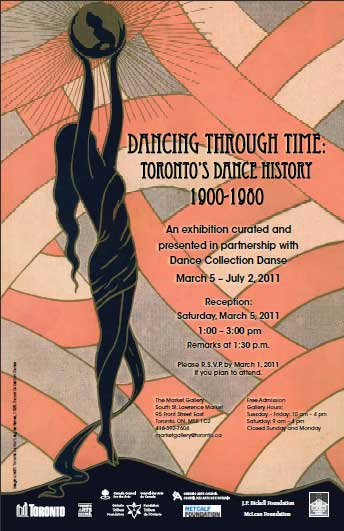
Dancing Through Time: Toronto’s Dance History 1900-1980
An exhibition curated and presented in partnership with Dance Collection Danse
March 5 – July 2, 2011
FREE Reception:
Saturday, March 5, 2011
1:00 – 3:00 pm
Remarks at 1:30 p.m.
Please R.S.V.P. by March 1, 2011
if you plan to attend.
The Market Gallery
South St. Lawrence Market
95 Front Street East
Toronto, ON M5E 1C2
416-392-7604
marketgallery@toronto.ca
Free Admission
Gallery Hours:
Tuesday – Friday: 10 am – 4 pm
Saturday: 9 am – 4 pm
Closed Sunday and Monday
Toronto, Ontario, Canada
News Release
February 24, 2011
Dancing Through Time: Toronto’s Dance History from 1900-1980
The Market Gallery presents an exhibition curated by Dance Collection Danse, Canada’s largest archives and research centre for theatrical dance history. “Dancing Through Time: Toronto’s Dance History from 1900-1980” will open on March 5 and continue through to July 2.
The exhibition outlines the development of the city’s dance scene by exploring influential touring artists and vaudevillians, the evolution of ballet and modern dance, and the growing diversity of dance forms in the late 20th century . The exhibition features costumes, photographs, playbills, programs, posters, designs, video and more. Many of the exhibition items have been rarely seen and have not been showcased at other museums.
Some of the featured artifacts are rare silk stockings and a practice tunic from the 1920s; sketches of the Ballets Russes by Grant Macdonald; a mask that toured to the 1936 Cultural Olympiad in Berlin and later survived Hurricane Hazel; costumes worn by famed National Ballet dancers David Adams and Lois Smith; and a Karen Kain doll. Visitors will discover the personalities and history of this dynamic art form that has contributed greatly to the city’s cultural vitality.
Landmarks of Toronto dance history will also be revealed. The Massey Hall performances of Russian ballerina Anna Pavlova and German Expressionist dancer Mary Wigman paved the way for ballet and modern dance teachers in the early 20th century. Teachers who escaped the Russian Revolution found it easier to establish schools after immigrating to Toronto because Pavlova’s tours had created a demand for lessons. Wigman inspired some of Toronto’s earliest modern dancers, such as Saida Gerrard and Cynthia Barrett – whose social consciousness found its way into the works they, and colleague Nancy Lima Dent, created for the New Dance Theatre, a group under the auspices of the United Jewish People’s Order.
Toronto’s vaudeville theatres created work for many young women including the Uptown Girls, a chorus line regularly featured at the Uptown Theatre. The ballet boom of the late 1940s and 1950s, catalyzed by the Canadian Ballet Festivals, provided an environment where the new National Ballet of Canada could flourish and become the renowned company it is today. The modern dance scene had its own boom period in the 1970s with the founding of Toronto Dance Theatre, 15 Dance Lab and the creation of Canada’s first university dance program at York.
Dance was the fastest growing art form in Canada in the 1970s and much of that growth was in Toronto. In this decade, the city began to see theatrical productions beyond ballet and modern dance with the arrival of artists who practised classical Indian dance forms and African and Caribbean dances.
Founded in 1986 by former National Ballet dancers Lawrence and Miriam Adams, Dance Collection Danse (DCD) is Canada’s national dance archives and publisher dedicated to the preservation and dissemination of Canadian theatrical dance history. Through Dance Collection Danse’s magazine, books and virtual exhibitions, DCD provides a context for the past and a foundation for the future of dance.
The Market Gallery is a program of the City of Toronto’s Cultural Services division and presents changing exhibitions dedicated to Toronto’s art, culture and history and offers educational programs for school groups and adults. The gallery is located on the second floor of South St. Lawrence Market, 95 Front St. E.. Admission is free. Gallery hours are Tuesday to Friday (10 a.m. to 4 p.m.), Saturday (9 a.m. to 4 p.m.). Closed Sunday, Monday and public holidays. More information is available at http://www.toronto.ca/culture/the_market_gallery.htm.
Toronto is Canada’s largest city and sixth largest government, and home to a diverse population of about 2.6 million people. Toronto’s government is dedicated to delivering customer service excellence, creating a transparent and accountable government, reducing the size and cost of government and building a transportation city. For information on non-emergency City services and programs, Toronto residents, businesses and visitors can dial 311, 24 hours a day, 7 days a week.
